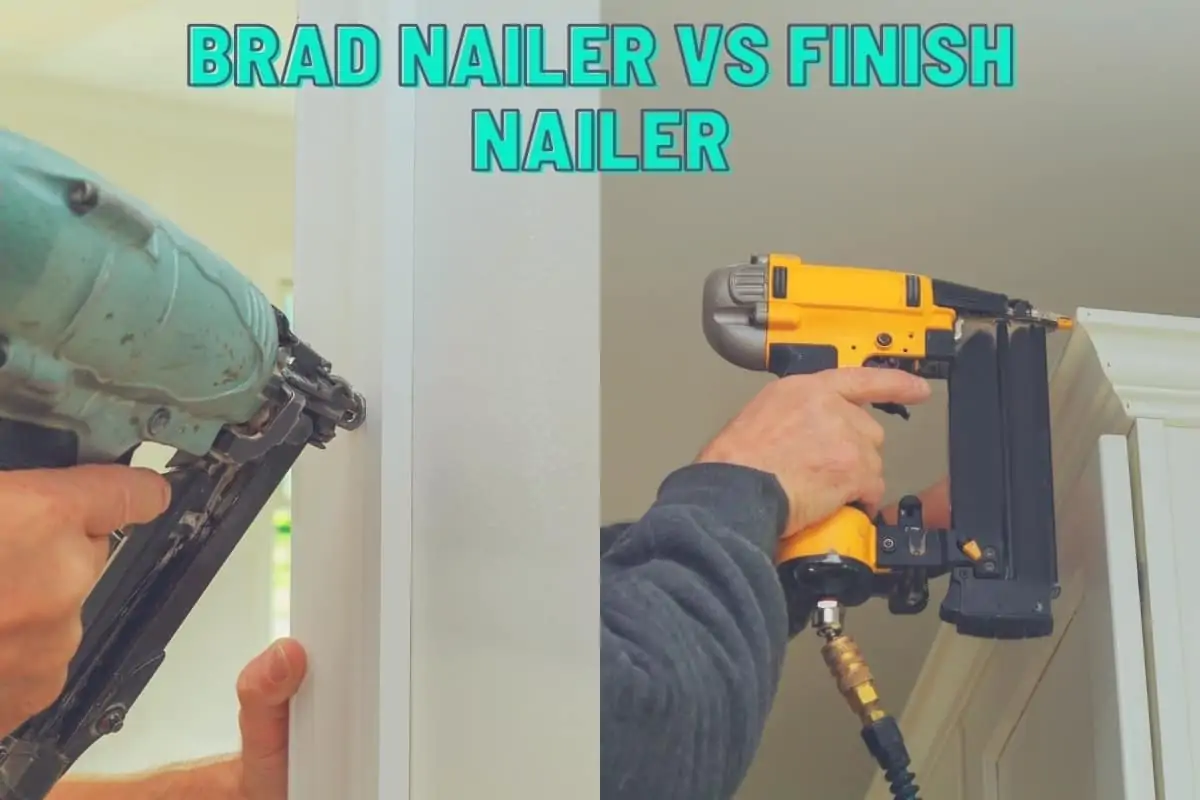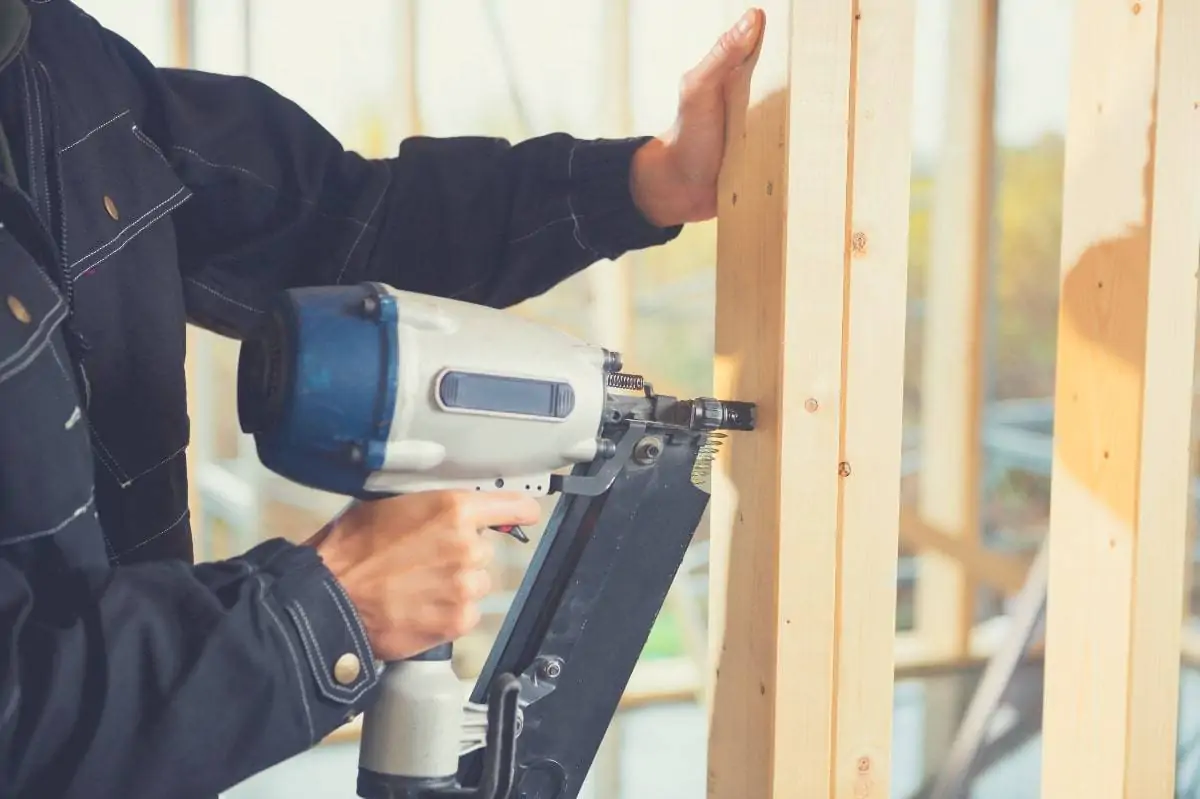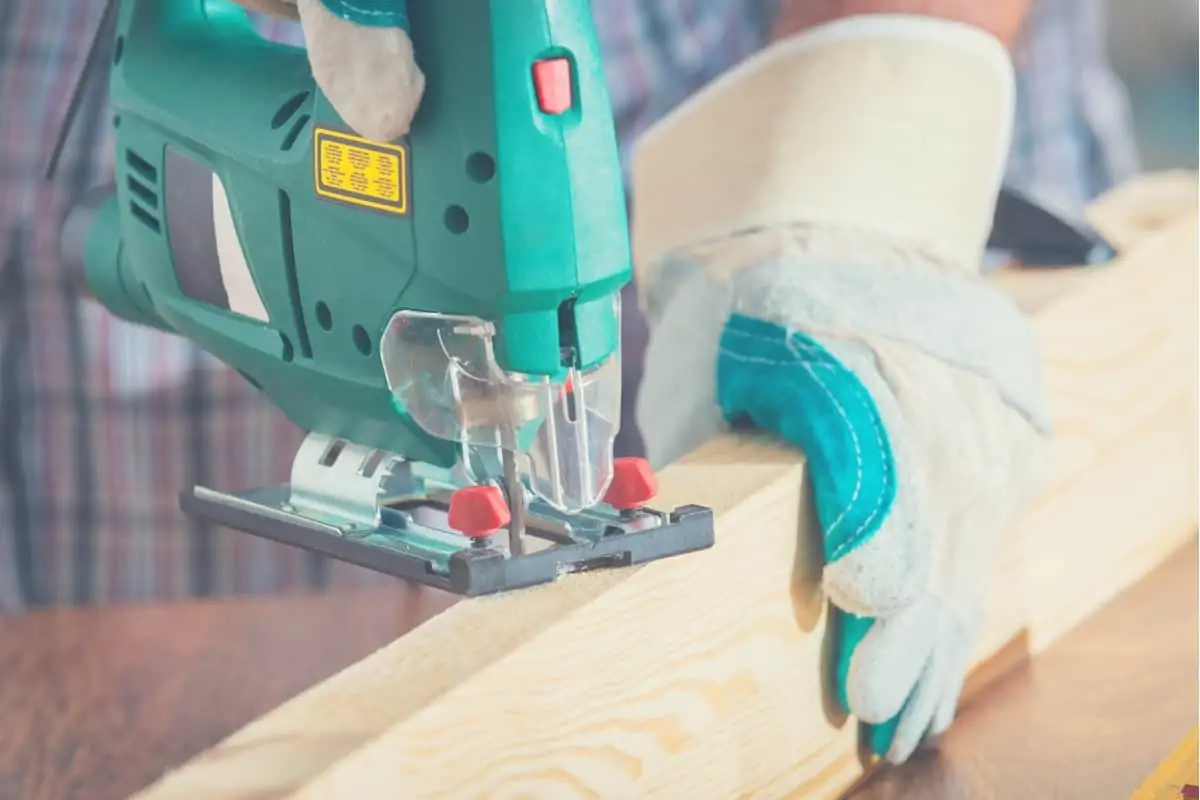Nailers are a top-rated power tool among DIY enthusiasts and woodworkers. You can use one for almost all kinds of projects. Two nailers that are more commonly used than any others are brad nailers and finish nailers. Weighing up a brad nailer vs finish nailer isn’t super straight forward on the face of it.
These nailers look almost identical, and the fasteners they use are also alike, which makes many people think they’re interchangeable. Such a resemblance might make it difficult for you to decide whether you should buy a brad nailer vs finish nailer.
The truth is that these tools are not in the least bit exchangeable. They are very different, and their uses vary.
In this article, I will explain how you can use each of these tools and help you appreciate the differences. At the end of the day, with the right information, you’ll be able to decide which nailing tool is best for your needs.
Brad Nailer
A brad nailer is a lightweight and easy-to-use nail gun that shoots brad nails. It looks and operates just like a nail gun but shoots brads instead.
Compared to the nails you might use in a finish gun, brad nails have a smaller head and are thinner. The nails this tool shoots are 18-gauge brad nails, with a length of between 5/8” to 2”.
Their size means less force is required, and you can quickly and easily use the nailer to secure delicate, thin moldings. You can work precisely, without having to worry about ruining your work.
The holes a brad nailer leaves are much smaller and less noticeable than those left by a finish nailer, and there is no risk of the wood splitting. Depending on the type of wood, you may not need to use wood putty or caulk to fill the holes.
One other difference is that it can’t provide the same holding power because it doesn’t use nails.
Brad Nailer Uses
If you’re at all concerned about splitting the work you’re working in, it’s best to use a brad nailer. The same applies if you want a thinner nail that makes less of a hole.
You can use a brad nailer for a variety of tasks, but the most common are:
- Attaching paneling
- Wood trim work
- Casing
- Installing baseboard
- Small woodworking projects such as picture frames
- Fastening decorative molding
- Temporary fixes when using glue
Brad Nailer Nails
Technically, a brad nailer doesn’t use nails at all. Instead, it uses brads. They are very different from the nails you use in a finish nailer. Formed from 18-gauge wire, they are much smaller in diameter, but don’t expect them to have as much holding strength.
A brad is headless and thinner, which means it’s easier to conceal, provides a cleaner finish, and requires no extra touch-up. There is also little chance of the surface spitting.
Brads are useful if you want to glue trim. When the glue is dry, you can remove them easily with pliers. They won’t damage the trim or leave any noticeable holes.
Brad Nailer Accuracy and User-Friendliness
Suppose you regularly need to apply molding or trimming delicately or apply the finishing touches to your woodworking or carpentry projects. In that case, a brad nailer will be a useful tool to have in your workshop.
This nail gun is smaller in size and lighter, which means you can operate it efficiently with one hand. One handed operation allows you to use your other hand to hold the material securely in place, right where you want it. The size of the gun and the brads it uses also allow you to be very precise.
If you’re just starting, a brad nailer is a good entry tool to have. It’s smaller and has a low delivery impact, which means you’ll soon get the handle on its ins and outs.
Brad Nailer Power
If you like the idea of a brad nailer, your next decision is whether to purchase a battery-powered, gas-powered, or pneumatic model. They each have their advantages and disadvantages.
A pneumatic model is lightweight, small, and very easy to use with one hand. However, your mobility is limited by the length of your air hose, and it’s a noisy tool to use.
Gas-powered cordless brad nailers rely on combustion to fire the brads. Their design mimics pneumatic guns because they use compressed gas fuel, together with a battery. The energy required to sink a brad is less than a finish nailer, which means the size of battery and fuel cell can be smaller.
On the other hand, a battery-powered model offers more flexibility because you’re not attached to a hose. Another advantage is that it tends to be a quieter machine. The downside is that it will be much heavier and bulkier because of the battery and its housing.
Something else to consider is the different firing cycles. A cordless model has a delay of about a minute before firing, whereas a pneumatic gun fires immediately when you pull the trigger. The latter is also one of the fastest firing mechanisms.
When it comes to cost, you can expect a cordless nailer to cost two to three times more, plus you need to get compatible batteries, which adds to the cost. For a pneumatic nailer, you’ve got to have an air compressor, so bear this in mind if you haven’t already got one.
Pros and Cons of a Brad Nailer
If you’re still undecided about whether a brad nail gun is for you, let’s look at the pros and cons.
Pros
- Suits delicate materials: A brad nailer is ideal for delicate or thin wood, especially if you’re worried about it splitting.
- Discrete finish: The nail head holes it leaves are small.
- Ideal glue substitute: Use a brad nailer when you want to hold things temporarily in place.
- Perfect for precision : You drive a brad is exactly where you want which is perfect for small projects such as picture frames, making jewelry boxes, or attaching edges to cabinetry or decorative trims.
- User-friendly: Lightweight and easy to use with one hand.
Cons
- Inflexibility: You can’t use it for large, thick pieces of wood, and the brads won’t penetrate MDF or plywood.
- Requires additional accessories: For a pneumatic nailer, you’ll need an air pump.
Finish Nailer
A finish nailer is larger than a brad nail gun. It also uses headless nails, which means it doesn’t leave much of a hole when it shoots the nail. Nevertheless, the hole left is larger than a brad nailer, so you’ll have to use wood filler but not as much as some other nail gun types.
The main difference between this and a brad nailer is the gauge of the nail. Typically, you’d use 15- or 16-gauge nails, which means they are thicker.
The increased thickness creates a stronger hold, so you can use them for attaching heavier things, such as heavy crown molding, cabinets, and baseboards.
Finish nailers are available in straight and angled designs. With an angled nailer, you can work in tight spaces.
Finish Nailer Uses
A finish nail gun is typically used for heavy-duty projects, especially if strength and holding power are vital. They are also commonly used for finishing a job, as the name implies. Some of the most routine jobs include:
- Exterior trim
- Staircases
- Hard and softwood flooring
- Window and door casings
- Installing crown and base moldings
- Chair rails
- Cabinets
Safety is of the utmost importance when using any type of nail gun. Every year they are responsible for an estimated 37,000 emergency room visits. Fortunately, nail gun injuries can be prevented. Watch these videos and learn how to use one safely.
Finish Nailer Nails
The nails this gun uses are either 15- or 16-gauge, which means they are thicker and therefore stronger than brads. The nails will be between 1” and 2 1/2” in length.
The nails are formed from heavier 15- or 16- gauge wire that allows them to hold a bigger payload. They are also designed to be permanent.
You can use this size nail for larger trim, including crown molding or baseboards. For larger woodwork and trim, increased support is essential.
The downside with this size nail is that it leaves a more obvious hole in the wood’s surface.
In most cases, further attention will be necessary, such as putty to conceal the nail’s insertion point.
When you purchase nails for your finish nailer, make sure you buy the right gauge. You can’t use 15-gauge nails in a 16-gauge nailer. Similarly, a 15-gauge nailer won’t accept 16-gauge nails.
Finish Nailer Accuracy and User-Friendliness
As a finish nailer is heavier duty, it’s better suited for more robust woodworking projects. It’s a more versatile nailer to have because you can use it on a broader range of materials.
You can use it on hardwoods, softwoods, and MDF woods such as plywood. A brad nailer would struggle with some of these.
With its stronger holding power, it’s more appropriate for fixing large pieces of wood and trim. The fact that an angled model is available increases its scope further.
Added features with some finish guns are an anti-damaging tip and rubber, which reduces damage to the workpiece.
On many models, you also can set the depth at which the gun shoots the nail. This does away with the need for additional tools for countersinking the nails, for example.
Finish Nailer Power
Just like a brad nailer, finish nailers can be either pneumatic, gas-powered, or battery-powered.
A pneumatic model is more powerful and lighter. However, you do have to worry about carrying an air hose behind you when you work, and the air hose can also be a trip hazard.
Gas or combustion finish nailers generate hammering power using internal combustion. The firing mechanism is fueled by a reservoir filled with a flammable gas. A little of the gas is released by an electronic control mechanism.
The gas is then vaporized by a small fan and mixed up with air particles. A gas-powered nailer utilizes a double trigger mechanism. You pull down the trigger and at the same time press the barrel against the surface, when you want to hammer in a nail.
Battery-powered models work more than adequately, but they’re best if you need to work on the top of a ladder, for example, or in awkward spaces.
Pros and Cons of a Finish Nailer
If you’re still sitting on the fence regarding your purchase of a nailer, let’s summarize the pros and cons.
Pros
- Strong fix: The nails are longer and bigger and come with added holding power, are non-removable, and act as permanent fasteners.
- Great for serious work: You can use a finish nailer for heavy-duty jobs such as crown moldings and baseboards.
- Versatility: A finish nail gun is very flexible as you can use it to fasten various wood materials, including plywood and MDF, drywall, and plaster.
- Varied depth setting: You can adjust the depth at which the gun shoots the nails.
Cons
- Heavy-handed: It is not the most delicate of tools.
- Leaves obvious holes: The holes will almost always need filling to make them less obtrusive.
Brad Nailer vs Finish Nailer FAQs
If you’re still undecided, let’s see if I can answer some of your questions.
What is a Nail Gauge?
The most common sizes are 15, 16, and 18. The higher the gauge number, the thinner the nail. A low number means a thicker nail. Gauge refers to the number of nails per inch. Typically a finishing nailer will use 15 of 16 gauge nails. Whereas a brad nailer will use 18 gauge brad nails.
Should I Get a Brad Nailer or a Finish Nailer?
The answer to this question depends on your personal needs. What kind of projects do you usually work on?
A brad nailer would be preferable if you’re regularly attaching thin moldings and trims.
On the other hand, a finishing nailer is excellent for door casings, finishing furniture, fixing large baseboard and plywood.
Both guns are designed for specific purposes rather than general use.
Can a Finish Nailer Use Brad Nails?
The simple answer is no! Brad nails are made from 18-gauge wire, whereas finish nails are made from thicker 15- or 16-gauge wire. These nails will be too thick to use in a brad nailer. Check the gauge of the nail gun you buy to ensure you always buy the correct size.
Can I Use a Brad Nailer for Baseboards?
Yes, brad nailers are suitable for baseboards. The brads this gun fires are generally 2” long, which is more than adequate for penetrating 2” thick drywall, 3/4” molding, or biting into wall studs or baseplate framing lumber.
Are Electric Brad Nailers Any Good?
There are some advantages to an electric brad nailer, compared with a pneumatic one. The biggest of which is that you can move around and use it because you’re not attached to and limited by an air hose.
An electric nailer is more expensive than a pneumatic one, but you don’t have to worry about buying an air compressor.
What about the disadvantages? There are a few more. An electric nailer is not as powerful, it’s heavier because of the battery and casings, and the nail delivery is not instant.
Think about the type of work you’re going to use your nailer for, as this will help you decide whether it will be a good purchase for you.
What Nail Gun is Best for Trim Work?
It depends on the trim you want to install. An 18-gauge nail gun (brad nailer) is better for fine detail work, thin trim work, and furniture repair. For thick trim, a 14- and 15-gauge nail gun (finish nailer) is more suitable.
Are 16 or 18 Gauge Nailers Thinner?
The higher the gauge number, the thinner the nail or brad. Therefore, 18-gauge nailers use thinner nails than a 16-gauge nailer.
Brad Nailer vs Finish Nailer – So Which is Best For Me?
Now you’ve finished reading my article, you should have a clearer idea of the differences between a brad and a finish nailer.
They each have their specific purposes. For example, brad nailers are great for accents and delicate work, and finish nailers are better for heavier and thicker materials such as crown molding.
If your projects tend to be somewhere between these parameters, you won’t go far wrong if you choose either one.
In the end, if you can’t make up your mind, consider the kinds of projects you’re going to tackle in the future or what you’re going to be doing more of. For small woodworking projects such as jewelry boxes and picture frames, a brad nailer will suit your purposes.
For future plans that include cabinets and furniture, a finish nailer will better fit the bill.
I’d love to hear what you decide, and if you’ve got anything further to add, please leave a comment. Good luck with your future projects.



